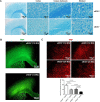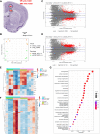White matter damage as a consequence of vascular dysfunction in a spontaneous mouse model of chronic mild chronic hypoperfusion with eNOS deficiency
- PMID: 35948662
- PMCID: PMC9734049
- DOI: 10.1038/s41380-022-01701-9
White matter damage as a consequence of vascular dysfunction in a spontaneous mouse model of chronic mild chronic hypoperfusion with eNOS deficiency
Abstract
Vascular cognitive impairment and dementia (VCID) is the second most common form of dementia after Alzheimer's disease (AD). Currently, the mechanistic insights into the evolution and progression of VCID remain elusive. White matter change represents an invariant feature. Compelling clinical neuroimaging and pathological evidence suggest a link between white matter changes and neurodegeneration. Our prior study detected hypoperfused lesions in mice with partial deficiency of endothelial nitric oxide (eNOS) at very young age, precisely matching to those hypoperfused areas identified in preclinical AD patients. White matter tracts are particularly susceptible to the vascular damage induced by chronic hypoperfusion. Using immunohistochemistry, we detected severe demyelination in the middle-aged eNOS-deficient mice. The demyelinated areas were confined to cortical and subcortical areas including the corpus callosum and hippocampus. The intensity of demyelination correlated with behavioral deficits of gait and associative recognition memory performances. By Evans blue angiography, we detected blood-brain barrier (BBB) leakage as another early pathological change affecting frontal and parietal cortex in eNOS-deficient mice. Sodium nitrate fortified drinking water provided to young and middle-aged eNOS-deficient mice completely prevented non-perfusion, BBB leakage, and white matter pathology, indicating that impaired endothelium-derived NO signaling may have caused these pathological events. Furthermore, genome-wide transcriptomic analysis revealed altered gene clusters most related to mitochondrial respiratory pathways selectively in the white matter of young eNOS-deficient mice. Using eNOS-deficient mice, we identified BBB breakdown and hypoperfusion as the two earliest pathological events, resulting from insufficient vascular NO signaling. We speculate that the compromised BBB and mild chronic hypoperfusion trigger vascular damage, along with oxidative stress and astrogliosis, accounting for the white matter pathological changes in the eNOS-deficient mouse model. We conclude that eNOS-deficient mice represent an ideal spontaneous evolving model for studying the earliest events leading to white matter changes, which will be instrumental to future therapeutic testing of drug candidates and for targeting novel/specific vascular mechanisms contributing to VCID and AD.
© 2022. The Author(s).
Conflict of interest statement
The authors declare no competing interests.
Figures






Similar articles
-
Partial eNOS deficiency causes spontaneous thrombotic cerebral infarction, amyloid angiopathy and cognitive impairment.Mol Neurodegener. 2015 Jun 24;10:24. doi: 10.1186/s13024-015-0020-0. Mol Neurodegener. 2015. PMID: 26104027 Free PMC article.
-
A mouse model of subcortical vascular dementia reflecting degeneration of cerebral white matter and microcirculation.J Cereb Blood Flow Metab. 2019 Jan;39(1):44-57. doi: 10.1177/0271678X17736963. Epub 2017 Oct 20. J Cereb Blood Flow Metab. 2019. PMID: 29053032 Free PMC article.
-
Deficiency of Nrf2 exacerbates white matter damage and microglia/macrophage levels in a mouse model of vascular cognitive impairment.J Neuroinflammation. 2020 Dec 1;17(1):367. doi: 10.1186/s12974-020-02038-2. J Neuroinflammation. 2020. PMID: 33261626 Free PMC article.
-
Chronic cerebral hypoperfusion: a key mechanism leading to vascular cognitive impairment and dementia. Closing the translational gap between rodent models and human vascular cognitive impairment and dementia.Clin Sci (Lond). 2017 Sep 28;131(19):2451-2468. doi: 10.1042/CS20160727. Print 2017 Oct 1. Clin Sci (Lond). 2017. PMID: 28963120 Review.
-
Endothelial Nitric Oxide Synthase-Deficient Mice: A Model of Spontaneous Cerebral Small-Vessel Disease.Am J Pathol. 2021 Nov;191(11):1932-1945. doi: 10.1016/j.ajpath.2021.02.022. Epub 2021 Mar 10. Am J Pathol. 2021. PMID: 33711310 Free PMC article. Review.
Cited by
-
Crucial role of microglia-mediated myelin sheath damage in vascular dementia: Antecedents and consequences.Neural Regen Res. 2026 Mar 1;21(3):1000-1012. doi: 10.4103/NRR.NRR-D-24-01109. Epub 2025 Mar 25. Neural Regen Res. 2026. PMID: 40145953 Free PMC article.
-
LMP2 deficiency causes abnormal metabolism, oxidative stress, neuroinflammation, myelin loss and neurobehavioral dysfunctions.J Transl Med. 2023 Mar 28;21(1):226. doi: 10.1186/s12967-023-04071-0. J Transl Med. 2023. PMID: 36978132 Free PMC article.
-
The CLDN5 gene at the blood-brain barrier in health and disease.Fluids Barriers CNS. 2023 Mar 28;20(1):22. doi: 10.1186/s12987-023-00424-5. Fluids Barriers CNS. 2023. PMID: 36978081 Free PMC article. Review.
-
Cerebrovascular Endothelial Dysfunction: Role of BACE1.Arterioscler Thromb Vasc Biol. 2024 Aug;44(8):1737-1747. doi: 10.1161/ATVBAHA.124.320798. Epub 2024 Jun 13. Arterioscler Thromb Vasc Biol. 2024. PMID: 38868939 Free PMC article. Review.
-
Interplay Between Vascular Dysfunction and Neurodegenerative Pathology: New Insights into Molecular Mechanisms and Management.Biomolecules. 2025 May 13;15(5):712. doi: 10.3390/biom15050712. Biomolecules. 2025. PMID: 40427605 Free PMC article. Review.
References
-
- Schneider JA, Arvanitakis Z, Bang W, Bennett DA. Mixed brain pathologies account for most dementia cases in community-dwelling older persons. Neurology. 2007;69:2197–204. - PubMed
-
- Hofman A, Ott A, Breteler MM, Bots ML, Slooter AJ, van Harskamp F, et al. Atherosclerosis, apolipoprotein E, and prevalence of dementia and Alzheimer’s disease in the Rotterdam study. Lancet. 1997;349:151–4. - PubMed
MeSH terms
Substances
Grants and funding
LinkOut - more resources
Full Text Sources
Medical
Molecular Biology Databases

